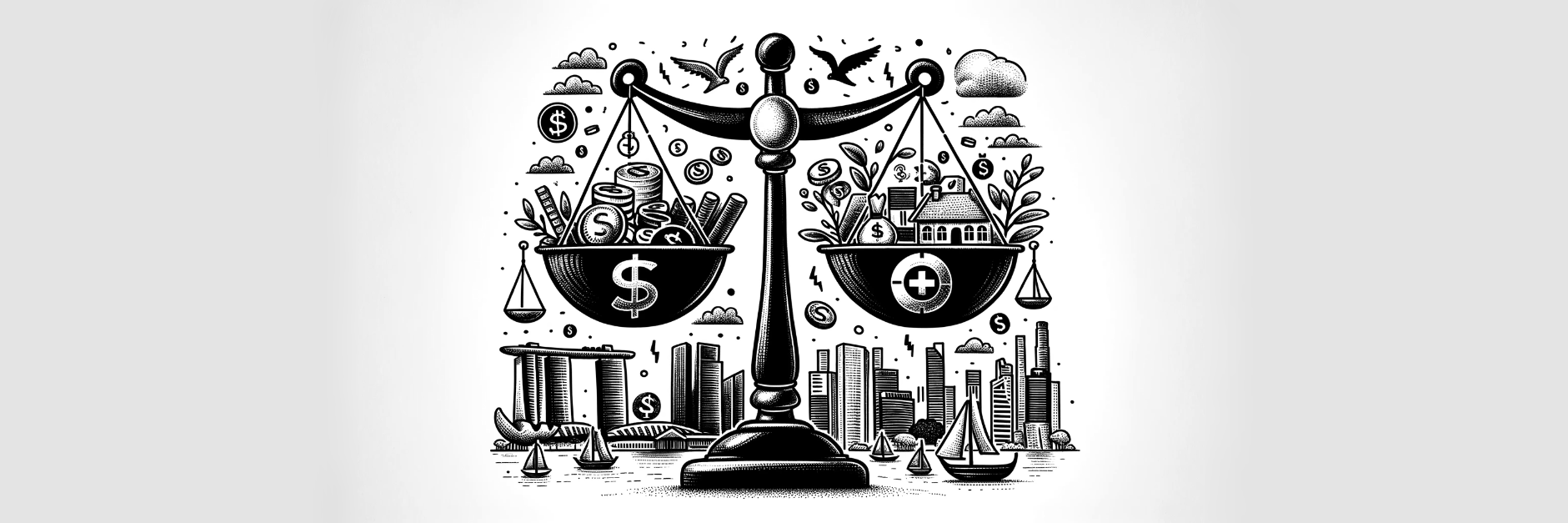Closing Your Protection Gap: Why Smart Singaporeans Insure Before They Invest
In the bustling financial hub of Singapore, investing is often seen as a key pathway to wealth and financial freedom. However, there’s a crucial step that many eager investors overlook: insurance. It’s time to challenge this mindset. In this article, I’ll write in detail, why closing your protection gap with adequate insurance coverage is not just advisable but essential before taking the plunge into investing.
The lure of the stock market, real estate, and other investment avenues can be strong. Tales of overnight successes and lucrative returns often dominate our social circles and media. But without a safety net, these ventures can be like walking a tightrope without a safety harness. This article aims to shift the focus back to what should be the first step in every Singaporean’s financial journey – ensuring adequate insurance coverage.
Every week, I’ll be sharing practical tips and invaluable knowledge to guide you on your path to financial independence.
The common misconception
Singaporeans are known for their savvy financial decisions, but when it comes to prioritizing investments over insurance, many are walking a thin line. The excitement of potential high returns from stocks or property often overshadows the more mundane, albeit crucial, aspect of financial planning: insurance. This common oversight stems from a mix of overconfidence in one’s financial management skills and a significant underestimation of life’s uncertainties.
The trend is particularly evident among young professionals who are just starting to build their wealth. The thought process is simple yet flawed: why put money into something that doesn’t promise immediate financial growth when you can invest it for potentially higher returns? This mindset, fueled by a culture that often equates success with investment portfolios, overlooks the fundamental purpose of insurance – protection against the unforeseen.
Understanding the role of insurance
The term ‘protection gap’ refers to the disparity between the insurance coverage one has and what one actually needs. It’s a gap that many Singaporeans, unfortunately, find themselves in. Essential insurance coverages such as health, life, disability, and critical illness are often either ignored or underestimated in terms of importance. However, these insurances are the bedrock of a sound financial plan.
Take, for instance, health insurance. In Singapore where medical costs are high, an unexpected health issue can derail not just your investment plans but also your existing assets. Life and disability insurance1ally important, given the rising incidence of such diseases and the associated costs.
The risks of prioritizing investments over insurance
Investing without a safety net is akin to building a house on a shaky foundation. The risks are multifaceted and can lead to dire financial consequences. In the best-case scenario, an uninsured investor might face significant financial strain due to unforeseen events. In the worst case, it could lead to bankruptcy and the loss of all invested assets. Personally, I would argue that it is a bad idea to even mix investments and insurance together because not only are these products of the complex structure, higher insurance costs and increased investment fees.
In Singapore, there have been instances where individuals have had to liquidate their investments at a loss to cover unexpected medical expenses or to support themselves after an unforeseen loss of income. This not only affects their current financial standing but also their future financial plans. These real-life examples highlight the perils of neglecting insurance in the pursuit of investment gains.
Without sufficient insurance coverage, Singaporeans face the risk of depleting their savings and investments in the event of a critical illness or disability. 1 in 5 Singaporeans are likely to be diagnosed with a critical illness in their lifetime.1 Therefore, having coverage of at least a year of income for early-stage and three years for late-stage critical illness is recommended.2
Insurance as the foundation of financial stability
Insurance should not be viewed merely as a contingency plan; it is the foundation upon which a stable financial future is built. It provides a safety net that cushions you against life’s uncertainties, allowing you to take calculated risks in your investment journey. With adequate insurance in place, you can afford to be more aggressive in your investment strategies, knowing that the basics are covered.
This approach is particularly relevant in the volatile world of investments. The financial markets are unpredictable, and while the highs can be exhilarating, the lows can be devastating. Insurance acts as a buffer, ensuring that your financial goals and aspirations don’t crumble under unforeseen circumstances. It’s about creating a balanced approach to wealth creation – one that acknowledges and prepares for risks while striving for growth.
Balancing Insurance and Investments
Achieving a balance between insurance coverage and investment is crucial. It’s not about choosing one over the other, but about integrating both into your financial strategy. This balance will vary depending on individual circumstances, including age, financial obligations, and risk appetite. For instance, a young professional without dependents might prioritise critical illness and health insurance, while someone nearing retirement might focus more on life insurance.
Tailoring your insurance and investment strategies to your life stage ensures that your financial plan evolves with your changing needs. For younger individuals, this might mean starting with a basic insurance plan and gradually increasing coverage as financial responsibilities grow. For those in their peak earning years, it might mean reassessing insurance to cover increased liabilities and ensuring that investments are aligned with retirement goals.
It is recommended that Singaporeans should not spend more than 15% of your salary on insurance protection3, considering their family situation and financial commitments. This ensures a safety net is in place without compromising the ability to invest. Considering that purchase of bundled insurance products (e.g. Whole Life Insurance) may exceed 15% of income as they contain both investment and protection elements, I wouldn’t recommend Singaporeans to consider them until they have their protection gap closed.
Here is a structure of my insurance portfolio built based on a time x income scenario and the total cost of insurance remains under $200 each month because I do not purchase bundled insurance products like Whole Life and Investment-Linked Policies:
- Death/Total Permanent Disability – 7.5 years of annual income
- Critical Illnesses (CI) – 5.5 years of annual income
- Early Stage of CI – 1 year of annual income
- Accidental Death – 5 years of annual income
Steps to Close the Protection Gap
Closing the protection gap requires a clear understanding of your current insurance status and your financial goals. Start by conducting a thorough review of your existing insurance policies. Are they sufficient to cover your needs and those of your dependents? Next, consider any changes in your life that might require adjustments to your coverage, such as marriage, the birth of a child, or a change in income.
Consulting with a financial advisor can be immensely beneficial. They can help assess your insurance needs and recommend suitable products. Comparing different insurance plans is also crucial to ensure you get the best coverage at a reasonable cost. Remember, the goal is not just to have insurance, but to have the right insurance that adequately covers the entirety of your protection gap with the least amount of money.
Conclusion
Investing without first addressing your insurance needs is like setting sail without a lifejacket. The perceived progress might be faster, but the risks are significantly higher. Insurance is not just about mitigating risks; it’s about ensuring that your journey towards financial goals is sustainable and secure. It’s time for Singaporeans to rethink their approach to financial planning, placing insurance where it rightfully belongs – at the very beginning.
I invite you to share your thoughts on this topic. Have you prioritised investments over insurance? How has this article influenced your perspective on financial planning? If you haven’t reviewed your insurance coverage recently, perhaps now is the time to do so. Remember, in the world of personal finance, being well-insured is not just being cautious – it’s being smart.
Sources:


hi Mickey, great article. yes Im with you on insure first and foremost. but like many people, how much is enough and what to insure on are always key questions. and any guideline on what is “adequate” or at least priortities of insurance given diff satges or scenarios of a reader to consider and draw reference to?
Hi DW, I don’t have a good framework for all the different life stages, but I would think of it from this perspective:
1) At the current life stage, who is dependent on my income to live?
2) If my income is disrupted, how much do I need to fund my expenses and those of my dependents.
With this, it should help you have a good idea of how much insurance coverage you would need.
Repeat the above when your life stage changes and the coverage needed may differ.
I have been wondering is it better to structure insurance based on annual income or annual expenses. Since income includes surpluses meant for savings / investment, one may end up over-insuring, especially if income is high. What do you think?
To keep it simple, I chose income because it is the higher of the two. I would think that the surplus would also act as a good buffer for the unexpected.
If you are an employee, then your biggest asset is your future employment income stream. Your insurance portfolio is missing disability income insurance, to deal with the risk that you can’t do your usual work.
Good point. I’ve been procrastinating on that and looks like it’s a good reminder for me to start examining this aspect of insurance. Thanks.